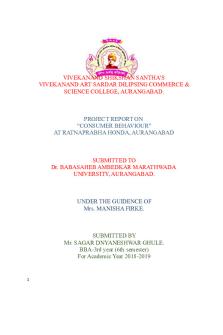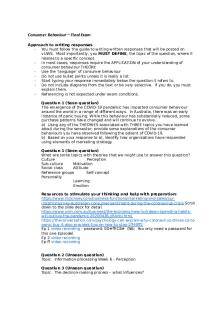Consumer Behaviour PDF

| Title | Consumer Behaviour |
|---|---|
| Course | Marketing II |
| Institution | Queen's University |
| Pages | 2 |
| File Size | 169.1 KB |
| File Type | |
| Total Downloads | 34 |
| Total Views | 192 |
Summary
Consumer Behaviour...
Description
Consumer Behaviour MKTG2112 Week 1: Outline of the course content: • “A discipline dealing with how and why consumers purchase (or do not purchase) goods and services” Definition: It is the dynamic interaction of affect, cognition behaviour and the environment by which humans conduct the exchange aspects of their lives • •
•
•
Situational influences o Physical, time, social, task, and antecedent Decision-process influences o Problem recognition o Information search o Alternative evaluation o Outlet selection o Purchase o Post-purchase activities Internal Influences o Needs, motives and emotions à receiving, processing and interpreting stimuli o Perceptions and memory à acquiring, storing and retrieving knowledge o Personality and lifestyle à psychological and psychosocial drivers of behaviour o Attitudes à nature, formation, change and measurement External Influences o Culture and values o Demographic, income and social class o References groups and households o Marketing activities
Consumer Decision Process (SITUATIONAL LEVEL OF INVOLVEMENT 1. Problem/need recognition a. The start of the process – the consumer recognises that a product is needed – actual state vs. desired state 2. Information search a. The consumer gathers information to assist with the purchase from ads, word of mouth, sales people, themselves, the internet 3. Evaluation of alternatives a. The consumer weighs up between the various choices such as: i. Best priced deal, quality, meeting of needs, convenience ii. Good size/ colour/ shape / packaging iii. Prior experiences and purchasing the product 4. Purchase decision a. The consumer makes the actual purchase i. Buy as intended/planned ii. Be influenced by in store deals and buy something else iii. Or buy extra products 5. Post-purchase behaviour a. The consumer has made the purchase i. Be happy with their purchase ii. Be regretful or concerned of the product iii. Word of mouth iv. Brand loyalty and repeat of purchase Marketing Decisions • Market segmentation o Target segment(s) o Single or multiple-target segments • Product positioning
•
o Key product-differentiation variables o Position relative to competition Marketing mix o Product features o Price level o Promotional appeal o Place (distribution)
Week I: readings Titus (2007) Applied Creativity • • • • • • •
As the competitive landscape has changed, so too has management’s response to those changes. Increased competitive pressures resulting from the rapid advances in technology, the continued growth of the service sector, and the escalation of global competition have led to a shift in managerial strategy. Businesses have begun to shift away from the strategic, bottom-line, cost-cutting focus of the 1990s to a renewed top-line focus on revenue growth via organizational innovation and creativity (Coy, 2000). As a result, businesses are clamoring for creative breakthrough ideas, products, and services that provide significant competitive advantages. This shift in strategic emphasis has been reinforced by business professionals that predict future market success will require corporations to embrace the challenge of integrating creativity and innovation into their organizations Ciardi (1956) defined creativity as the “imaginatively gifted recombination of known elements into something new.” The recent shift in strategic thinking is likely to have the effect of elevating the stature and importance of marketing within the business firm and community.
Creative Marketing Breakthrough Model • Cognitive flexibility has long been viewed as a desired trait for those wishing to enhance their creative output and is included as a key component of the CMB model. Individuals that consistently use alternative approaches or pathways to solve difficult problems are said to be cognitively flexible in their thinking. • Serendipity: the occurrence and development of events by chance in a happy or beneficial way. • Disciplinary knowledge: individuals involved in creative work generally operate within a particular industry, discipline, or area of expertise. Over time, employees acquire significant amounts of knowledge about their respective disciplines. • Task motivation: Thomas Edison explicitly recognized the importance of motivation when he observed inventive genius to involve “99% perspiration and 1% inspiration”. The absence of sufficient task motivation can lead individuals to prematurely abandon the creative effort and thereby fail to realize valuable creative breakthroughs. Week 2: Decision process I: situation and problem recognition A situation can be defined as the set of factors other than the individual consumer and the stimulus object to which the consumer might react à the nature of a situation can determine whether a consumer approaches a consumption decision with a more rational or a more emotion orientation Dan Ariely à discusses how we engage in consumer decision process and defines how behaviour and perceptions influence customer choice • In marketing, the decoy effect (or asymmetric dominance effect) is the phenomenon whereby consumers will tend to have a specific change in preference between two options when also presented with a third option that is asymmetrically dominated. Stimuli à consumer à response Situations relevant to the consumption process
!...
Similar Free PDFs

Consumer behaviour
- 16 Pages

Consumer behaviour
- 17 Pages

Consumer Behaviour
- 2 Pages

Notes - Summary Consumer Behaviour
- 29 Pages

Consumer behaviour 2
- 21 Pages

Consumer Behaviour Exam Notes
- 45 Pages

Consumer Behaviour Notes
- 77 Pages

Consumer Behaviour Lecture 2
- 8 Pages

Chapter 6 Consumer Behaviour
- 10 Pages

Chapter 3: consumer behaviour
- 13 Pages

Consumer Behaviour Project
- 37 Pages

Consumer Behaviour Notes
- 59 Pages

Consumer Behaviour Final Exam
- 2 Pages

CONSUMER BUYING BEHAVIOUR
- 6 Pages
Popular Institutions
- Tinajero National High School - Annex
- Politeknik Caltex Riau
- Yokohama City University
- SGT University
- University of Al-Qadisiyah
- Divine Word College of Vigan
- Techniek College Rotterdam
- Universidade de Santiago
- Universiti Teknologi MARA Cawangan Johor Kampus Pasir Gudang
- Poltekkes Kemenkes Yogyakarta
- Baguio City National High School
- Colegio san marcos
- preparatoria uno
- Centro de Bachillerato Tecnológico Industrial y de Servicios No. 107
- Dalian Maritime University
- Quang Trung Secondary School
- Colegio Tecnológico en Informática
- Corporación Regional de Educación Superior
- Grupo CEDVA
- Dar Al Uloom University
- Centro de Estudios Preuniversitarios de la Universidad Nacional de Ingeniería
- 上智大学
- Aakash International School, Nuna Majara
- San Felipe Neri Catholic School
- Kang Chiao International School - New Taipei City
- Misamis Occidental National High School
- Institución Educativa Escuela Normal Juan Ladrilleros
- Kolehiyo ng Pantukan
- Batanes State College
- Instituto Continental
- Sekolah Menengah Kejuruan Kesehatan Kaltara (Tarakan)
- Colegio de La Inmaculada Concepcion - Cebu

